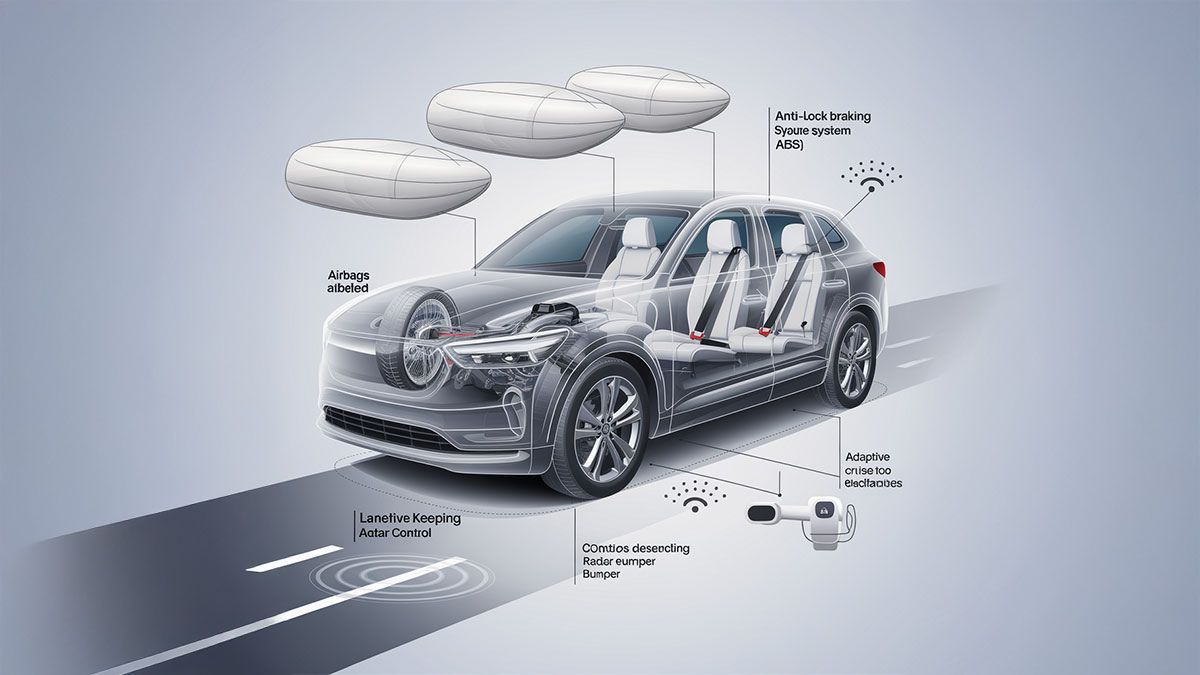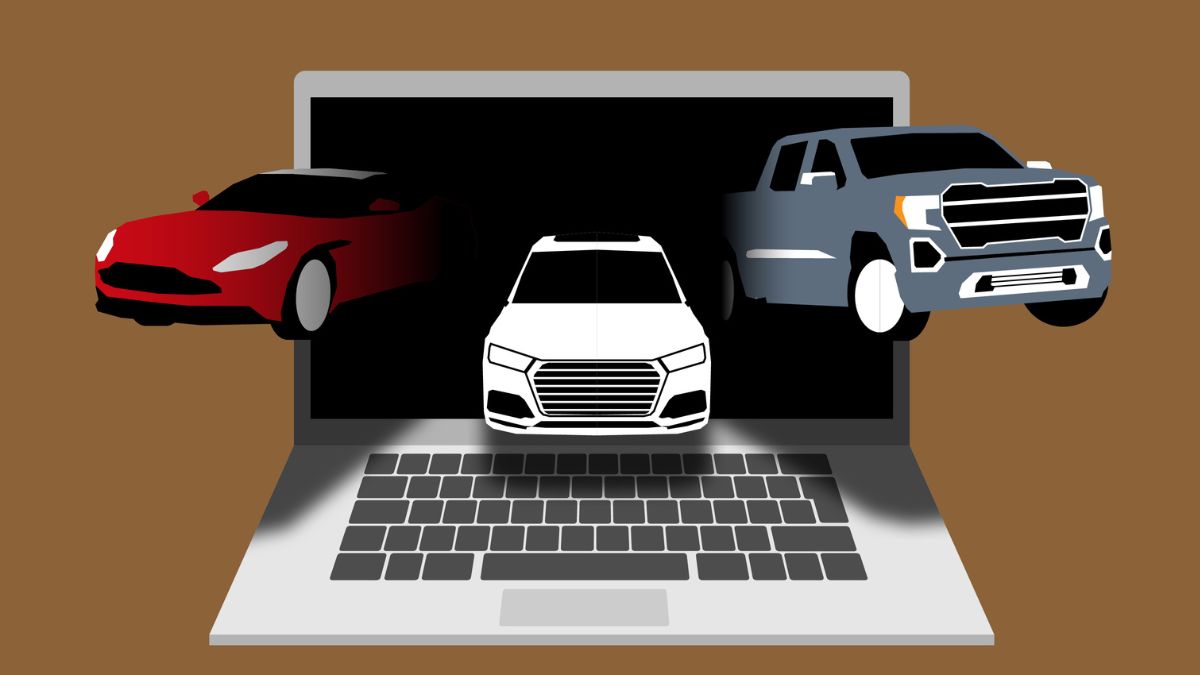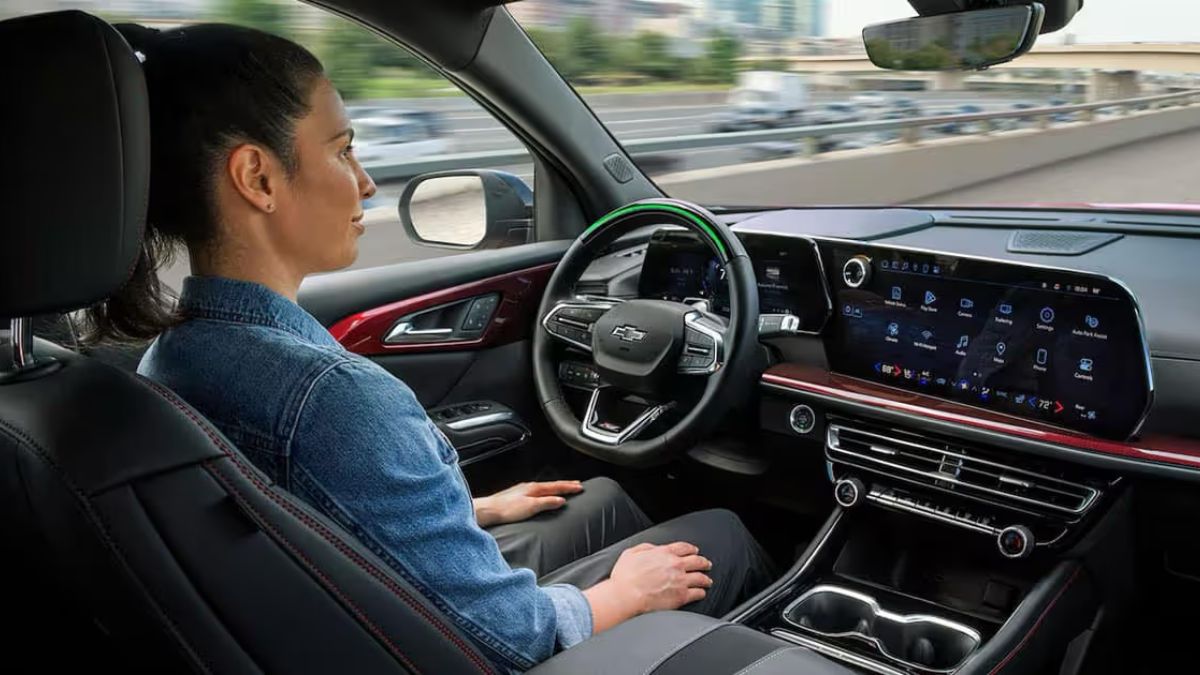AUTOMOTIVE
How Vehicle Size and Safety Features Protect You in a Crash

How often have your driving instructors told you to consider all the safety features before buying a vehicle? Driving schools even have basic vehicle control lessons to introduce new drivers to all the features of the car they’re learning to drive. In this era, road safety is not just a goal, it’s a necessity. Choosing a vehicle with the right safety features can go a long way in ensuring personal and road safety. Vehicles today come with many new technologies like advanced driver assistance or collision avoidance. These vehicles are designed not only to help prevent accidents but also to reduce the impact and injuries when they occur. In this post, we will explore why vehicle size and structure matter in accidents and how some safety features can help protect you in risky situations. Whether you’re a new driver searching for a suitable vehicle or a seasoned driver looking to upgrade, having this knowledge can help you make informed decisions.
How Vehicle Size and Structure Matter
The size and structure of a vehicle make a big difference in the result of a crash. They affect the nature and severity of injuries as well as the damage to the car. Large vehicles can absorb heavy impact forces and avoid severe damage during accidents. Heavy vehicles also have the weight to help them absorb the high force of a crash without retaining much damage. The structure of a vehicle also plays a big role in offering protection to its occupants. Large cars are often specially designed to protect the cabin. Most vehicles with longer fronts have additional crumple zones to absorb the impact of the collision and prevent injury to the passengers. Understanding the effect of vehicle size and weight can help you choose better vehicles more suited to ensure safety for you and others on the road.
Vehicle Safety Features That Help
One of the first driving lessons for new drivers in most driving school is an introduction to the main features, especially safety features, of the vehicle they’re learning to drive. Here are some of the common safety features in modern vehicles that enhance driver safety and help keep the roads safe too:
Airbags: The Soft Life-Savers
All modern vehicles have airbags, the first and most fundamental defence or protection in a crash. When a car collides with anything, the airbags blow up in front and sides of the passengers. They are like huge cushions that absorb the crash impact while protecting the passengers from hitting hard surfaces.
Anti-lock Braking System (ABS)
Most vehicles today also have a special feature called Anti-lock braking. In case of emergency braking, drivers can lose control of their vehicles and cause them to skid across the road, especially if the surface is wet or slippery. In such cases, an Anti-lock braking system stops the wheels from locking up and helps the driver retain control of the car.
Electronic Stability Control (ESC)
An advantage of having modern technology is the latest innovations like the Electronic Stability Control (ECS). As the name suggests, it helps provide stability and vehicle control and prevents accidents. It helps detect when any of the car’s tyres are losing traction and applies brakes to those individual tyres. This can stabilize the tyres and prevent skidding, thus preventing accidents and reducing risk to road safety.
Crumple Zones
Crumple zones are designed to protect passengers in a crash. They are often placed at the front and rear of the vehicle to absorb the energy of the impact and prevent it from reaching the passengers. They bear the maximum brunt of the collision, so the force that passengers feel is greatly reduced. Crumple zones protect passengers from major damage in a crash and thus ensure safety.
Seat Belts
The most basic yet safest feature of any vehicle is the seatbelt. They are used to keep the passengers secured to their seats in case of a collision. The impact of a crash can propel the passengers from their seats with force. Without a seatbelt, they can be thrown out of the front mirror or collide with car controls dispensing on the force of the crash. Seat belts can help keep the passengers in their seats and prevent any serious injury or damage.
Advanced Driver Assistance Systems (ADAS)
ADAS features detect hazards and take preventive actions, reducing the likelihood of a crash. Advanced driver assistance systems (ADAS) are one of the best and most advanced safety features available in vehicles these days. Driver assistance systems can help drivers with steering and acceleration, provide warning when necessary, and offer adaptive features like cruise control to make driving easier and safer for drivers.
Ensuring Safety on the Road
The vehicle size and advanced safety features play a crucial role in protecting you during a crash. Larger vehicles often provide more physical protection due to their weight and structure. Similarly, advanced safety technologies such as airbags, anti-lock braking systems, and collision avoidance systems add an extra layer of security. However, safety is not just about the vehicle; it’s also about responsible driving and regular vehicle maintenance. By combining thoughtful vehicle selection with safe driving practices, you can significantly enhance your chances of avoiding accidents and staying protected on the road. You can learn to drive safely by joining the Safer Drivers course from a local driving school. Remember, ensuring road safety is the responsibility of all road users!
AUTOMOTIVE
Why Visiting a Local Dealership Beats Online-Only Car Buying

Online shopping has made buying everything from groceries to furniture more convenient, and now even cars can be purchased with a few clicks. While this seems like a modern solution to an old problem, skipping the dealership entirely might not be the win it first appears to be. The ease of online browsing can’t replace the value of personal interaction, real-time assistance, and hands-on experiences that only a local dealership can provide. We will explore the many reasons why visiting a dealership in person still offers a significant advantage over conducting everything online.
Why Face-to-Face Still Matters in Car Buying
You Can Physically Inspect and Test the Car
There is a world of difference between seeing a car in pictures and experiencing it in person. A local dealership offers the chance to sit inside the vehicle, adjust the seat, feel the interior materials, test the infotainment system, and understand how everything fits you. Pictures online can be flattering, but they can’t convey the full story. Even a vehicle that looks perfect in digital form might have blind spots you hadn’t anticipated or seat comfort that doesn’t quite match your expectations. A dealership visit helps you assess a car in real-world terms, not just how it looks in ideal lighting.
Searching for car dealerships near me can lead you to nearby locations where you can also test drive the car, which is arguably one of the most important parts of making a final decision. The drive helps you gauge acceleration, braking, steering, and suspension—details that can’t be captured in a photo gallery or video walkaround. Local dealerships give you a tangible sense of ownership that online platforms simply can’t match.
Human Conversations Lead to Better Deals
When buying a car online, you’re usually limited to preset pricing with little to no room for negotiation. At a dealership, however, you’re engaging with a real person who is motivated to sell. That opens the door to asking questions, discussing options, and even negotiating on price, trade-in value, and financing. You can express concerns, clarify terms, and receive immediate feedback rather than waiting for emails or dealing with customer service bots. More importantly, the presence of a knowledgeable sales representative can make a real difference in understanding promotions, discounts, or packages that might not be visible online. Buying a car is not just a financial decision but a personal one, and human conversation allows for flexibility that rigid online systems can’t offer. At a dealership, you might walk out with a deal that wasn’t even advertised—something you’d never uncover with online-only shopping.
You Get Immediate Help With Paperwork and Financing
Purchasing a car isn’t as simple as clicking “Add to Cart.” It involves multiple steps like title transfers, tax documentation, insurance proof, and more. While online services try to simplify the process, they often lead to confusion, missed documents, or delivery delays. Visiting a local dealership allows you to handle everything in one visit. The dealership staff can guide you through the paperwork, explain any terms you may not understand, and ensure that every box is checked.
For financing, you’ll likely have access to a variety of loan or lease options through the dealership’s network of lenders. That gives you better odds of securing terms that fit your financial situation. Instead of hunting down your financing and guessing your eligibility, you get practical assistance on the spot. This efficiency can significantly reduce the stress and uncertainty that often accompany major purchases, such as vehicles.
You Build a Relationship With a Local Business
Buying a car is not a one-time interaction. Vehicles require maintenance, service, and sometimes warranty support. Purchasing from a local dealership connects you to a long-term support network. When issues arise or questions pop up, you know exactly where to go and who to speak to. A dealership that values customer relationships is likely to go the extra mile to keep you satisfied, not just at the time of purchase, but for years afterward. This relationship can come in handy when you’re ready to upgrade, want to trade in your vehicle, or need help scheduling a service appointment.
Also, working with a business that’s part of your community means you’re supporting the local economy. Online-only platforms don’t offer personalized after-sale service and often rely on third-party mechanics who have no history with your vehicle. Local dealerships understand your vehicle’s journey from the very beginning, which makes follow-up visits easier and more efficient.
There’s Greater Transparency and Peace of Mind
It’s hard to trust a website with a major life purchase. While many online retailers offer guarantees and return policies, there’s still a degree of uncertainty. Pictures can hide flaws. Reviews may not reflect your experience. And delays in delivery or unexpected fees can ruin what seemed like a great deal. Visiting a dealership, on the other hand, offers full transparency. You get to see the exact vehicle you’re buying, verify its condition, review the history report in person, and have all your questions answered. This immediate clarity helps you feel confident about your purchase. You’re not relying on digital promises; you’re making an informed decision based on first-hand experience. That peace of mind is priceless, especially when investing in something as important as a vehicle that needs to serve you for years to come.
The convenience of online car buying may seem appealing at first glance, but it lacks the essential benefits of in-person experiences. From test-driving and personal negotiations to real-time support and community trust, visiting a local dealership ensures a smoother, more transparent, and more satisfying experience. Local dealerships do more than just sell cars—they provide a comprehensive, human-centered experience that turns a transaction into a relationship. When making a major purchase, such as a vehicle, that kind of connection matters more than ever.
AUTOMOTIVE
How to Choose the Right Chevy Model for Your Lifestyle

Choosing a vehicle is more than just picking a car that looks good or fits your budget. It is about finding the one that fits seamlessly into your daily life, matching your habits, needs, and preferences. Chevrolet offers a wide variety of models, from compact cars to rugged trucks and spacious SUVs. Each model serves a unique purpose, and the right choice depends on how you plan to use it. We will explore the key considerations to help you find the Chevy model that aligns perfectly with your lifestyle, making your driving experience enjoyable and practical.
Key Considerations for Picking the Perfect Chevy Model
Evaluate Your Daily Driving Needs and Environment
Before choosing a Chevy, it’s important to think about how and where you will mostly be driving. Visiting a trusted Chevrolet dealer near me can give you the chance to explore different models in person and get a feel for what suits your needs. If your day-to-day involves short city commutes, parking in tight spaces, and navigating heavy traffic, a smaller, more agile model like the Chevy Spark or Malibu might suit you well. These models offer better fuel efficiency and are easier to maneuver through urban environments.
On the other hand, if you live in a rural area or frequently travel long distances on highways, a more comfortable and spacious vehicle, such as the Chevy Equinox or Traverse, can provide a smoother ride and more room for passengers or cargo. Weather and terrain also play a significant role—if you frequently encounter rough roads, snow, or off-road conditions, opting for an SUV or truck with all-wheel or four-wheel drive capabilities ensures better handling and safety. Understanding your daily routes and conditions helps narrow down the models that best fit your driving habits.
Consider Passenger and Cargo Space Requirements
Another essential aspect to consider is how many people you typically travel with and how much cargo you carry. If you often have passengers—family members, friends, or colleagues—or you require extra room for pets or equipment, larger Chevy SUVs like the Traverse or Tahoe provide generous seating capacity and flexible cargo space. These models feature multiple rows of seats and configurations that facilitate easier accommodation of both passengers and luggage.
For those who mostly drive alone or with one other person and rarely haul large items, smaller models like the Chevy Cruze or Trailblazer offer sufficient space without the bulkiness of larger vehicles. Even pickup trucks, such as the Chevy Silverado, can serve those who need both passenger space and a truck bed for carrying tools, sports gear, or home improvement materials. Identifying your passenger and cargo needs early on helps prevent the frustration of a vehicle that feels cramped or unable to handle your belongings comfortably.
Match the Vehicle’s Performance to Your Lifestyle
Performance is more than just horsepower or speed—it’s about how the vehicle responds to your driving style and lifestyle demands. Chevy provides a range of engine options and trims designed to suit various performance expectations. If you enjoy a spirited drive or often find yourself on highways needing quick acceleration, models with turbocharged engines or larger displacement engines deliver that extra punch. The Chevy Camaro, for instance, is a choice for those who appreciate a sporty, dynamic driving experience. On the contrary, if fuel economy and daily practicality take priority, then models designed for efficiency, such as the Chevy Bolt EV or smaller sedans, reduce fuel stops and save money over time.
Additionally, consider towing capacity if you plan to haul trailers, boats, or campers—trucks like the Silverado or SUVs like the Tahoe are built for such demands. Matching performance features to what your day-to-day or weekend activities require ensures your Chevy keeps up with your pace without compromising comfort or capability.
Think About Technology and Connectivity Needs
Modern vehicles are packed with technology, but not everyone needs every feature available. It helps to identify which technology aspects are essential to your lifestyle. If you spend a lot of time in your vehicle, features such as a high-quality sound system, advanced infotainment, and smartphone integration (Apple CarPlay, Android Auto) can enhance your driving experience. Chevy models generally include these features, but the level of sophistication varies by trim and model. Safety technologies, such as blind-spot monitoring, lane-keeping assist, and adaptive cruise control, may be more crucial if you commute long distances or frequently drive in busy traffic.
On the other hand, if your trips are short and local, simpler setups might suffice. Also consider comfort technologies like heated seats or remote start, which can make a significant difference in colder climates or early mornings. Listing the tech and comfort features that you use or desire helps you narrow down the right Chevy model and trim level.
Finding the Chevy that fits your lifestyle requires a clear assessment of how you live, drive, and spend your time in a vehicle. By carefully considering daily driving habits, space requirements, performance needs, technology preferences, and budget constraints, you set yourself up for a satisfying ownership experience. Chevrolet’s range is broad, with each model offering unique qualities tailored to different lifestyles. Taking time to match your lifestyle with the right model means your Chevy will serve not just as transportation, but as a trusted companion for all your journeys.
AUTOMOTIVE
Tips for Negotiating the Most Advantageous Price at a Ford Dealership

Negotiating a vehicle price can often feel daunting, especially at a large dealership like Ford, where many factors influence the final cost. Securing a fair deal requires preparation, confidence, and a clear understanding of how dealership pricing works. Whether you’re purchasing a new Ford model or a certified pre-owned vehicle, knowing how to approach negotiations can save you significant money and frustration. We will explore practical tips that empower you to engage confidently with sales representatives, helping you secure a price that reflects both market value and your budget without compromising on quality or features.
Effective Strategies for Negotiating at a Ford Dealership
-
Do Thorough Research Before Visiting the Dealership
Preparation is essential when entering negotiations at a Ford dealership. Start by gathering detailed information about the vehicle models you are interested in, including their manufacturer’s suggested retail price (MSRP), invoice price, and any ongoing promotions or incentives. Use reputable online resources to compare prices of cars for sale across different dealerships in your area to understand the typical market range. Additionally, familiarize yourself with the vehicle’s features, safety ratings, and fuel economy to ensure you know exactly what you’re getting for your money. Being informed puts you in a strong position to spot inflated prices and identify reasonable offers. This research also helps you avoid being swayed by aggressive sales tactics and keeps the conversation grounded in facts.
-
Understand Your Financing Options and Credit Situation
Before stepping onto the dealership lot, take a moment to evaluate your financing options. Check your credit score and consider obtaining pre-approval for a loan through your bank or credit union. Having a pre-approved loan in hand not only provides a clear budget limit but also strengthens your bargaining position, as you can negotiate as a cash buyer without being dependent on dealership financing. Dealerships often attempt to increase their profit by adjusting loan terms, so knowing your options prevents surprises. Moreover, understanding interest rates and loan durations helps you negotiate the total cost of the vehicle, rather than focusing solely on the monthly payment, which can be misleading.
-
Schedule Your Visit Toward the End of the Month or Quarter
Timing your visit strategically can have a significant impact on the deal you receive. Dealerships frequently operate with monthly or quarterly sales targets, and salespeople may be more willing to negotiate as these deadlines approach to meet their goals. Visiting toward the end of these periods increases the likelihood that you will encounter a motivated salesperson willing to offer more attractive pricing or incentives. Keep in mind that weekends or holidays may experience higher customer traffic and less flexibility, so mid-week visits offer a calmer environment and more personalized attention. While timing alone won’t guarantee a better price, combined with other negotiation tactics, it can improve your chances of securing favorable terms.
-
Be Ready to Walk Away
One of the most powerful negotiating tools is the willingness to leave the deal if terms don’t meet your expectations. Sales representatives recognize that a buyer who appears too eager or desperate to purchase loses leverage. Demonstrating patience and a readiness to explore other dealerships or wait for better offers signals that you value your investment and are not rushing into a decision. Walking away can sometimes prompt the salesperson to reconsider their offer or involve a manager to provide additional discounts. Remember, the vehicle market is competitive, and there is no shortage of options. Maintaining control of the situation by setting clear boundaries on what you’re willing to pay keeps negotiations balanced and fair.
-
Negotiate Price Before Discussing Trade-Ins or Financing
When you have a trade-in vehicle or require dealership financing, it’s essential to separate these components during the negotiation process. Start by agreeing on the purchase price of the new vehicle before introducing your trade-in or financing needs. Mixing these discussions can obscure the actual price and make it difficult to determine if you are getting a fair deal on either transaction. Dealers may offer attractive trade-in values, but they often increase the new vehicle’s price or vice versa. By isolating each negotiation, you maintain transparency and clarity, which helps you evaluate the fairness of each element individually and avoid being misled by bundled offers.
-
Ask About Additional Fees and Documentation Charges
Beyond the sticker price, dealerships often include various fees such as documentation fees, destination charges, and preparation costs. These additional costs can add hundreds or even thousands to your final bill if you are not aware of them upfront. Make it a point to request a full breakdown of all fees before agreeing to any deal. Understanding which fees are mandatory and which ones might be negotiable allows you to address unnecessary charges directly. Some dealerships may be willing to waive or reduce certain fees to close the sale, so don’t hesitate to inquire. Transparency in this area ensures that there are no unpleasant surprises during the final paperwork phase.
Negotiating a vehicle price at a Ford dealership requires a mix of preparation, strategy, and confidence. Researching the market, understanding financing, and timing your visit lay a strong foundation. Keeping negotiations transparent by separating price discussions from trade-ins and financing prevents confusion. Being willing to walk away and asking about all fees protects you from overpaying. Leveraging available incentives and bringing a trusted companion can further enhance your negotiating position. By applying these approaches, you will navigate the process with greater assurance and secure a deal that reflects true value and aligns with your financial goals.
-

 TECHNOLOGY2 weeks ago
TECHNOLOGY2 weeks agoTop 10 Must-Read Stories from Kristen Archives You Can’t Miss
-

 TECHNOLOGY6 months ago
TECHNOLOGY6 months agoSky Bri Net Worth Revealed: How She Built Her Financial Empire
-

 TOPIC8 months ago
TOPIC8 months agoBasement Renovation Contractors: How They Tackle Structural Issues During Renovations
-

 TOPIC3 months ago
TOPIC3 months ago5 Reasons the //Vital-Mag.Net Blog Dominates Lifestyle
-

 TOPIC1 month ago
TOPIC1 month agoTop 10 Articles from the ://Vital-Mag.net Blog That You Can’t Miss
-

 CRYPTO5 months ago
CRYPTO5 months agoCrypto30x.com Review: Is It the Right Platform for You?
-

 BUSINESS2 weeks ago
BUSINESS2 weeks agoTraceLoans Explained What You Need to Know
-

 BUSINESS4 weeks ago
BUSINESS4 weeks agoDecoding the Kennedy Funding Ripoff Report: Facts vs. Fiction
